Last Updated on January 28, 2025 by teamobn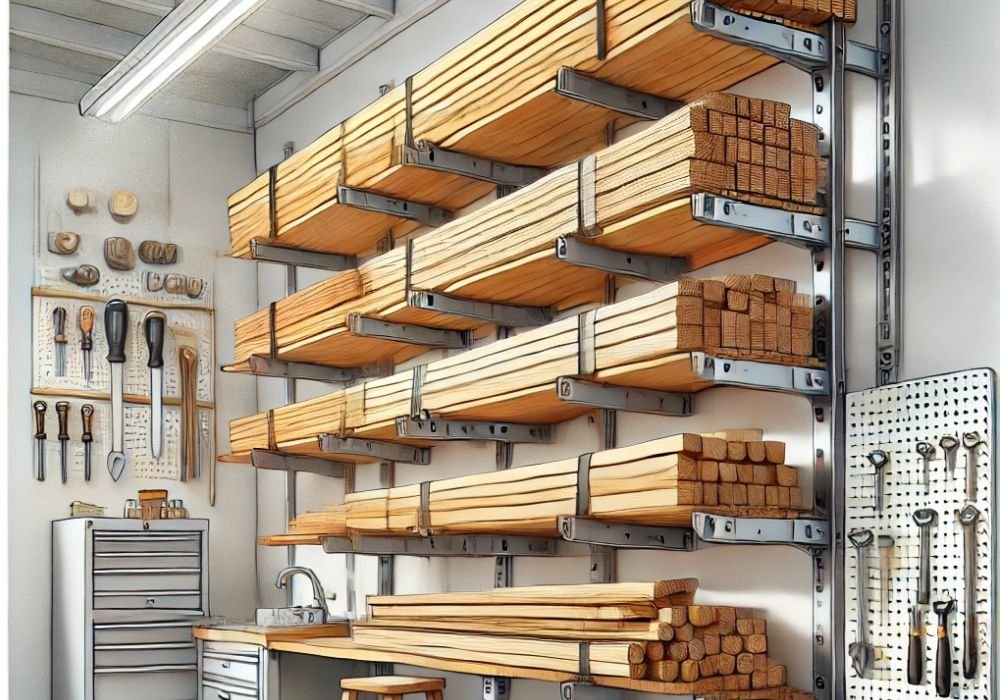
DIYers and homeowners renovating need efficient lumber rack ideas. Small areas may rapidly get congested, making organizing and accessing goods hard. A well-designed lumber rack may improve the workspace and protect the wood from warping, dampness, and damage. Selecting the appropriate lumber rack may streamline work and boost productivity for any artisan.
Contents
Smart Lumber Rack Ideas
Here are five of the greatest small-space lumber rack solutions. These creative, practical solutions maximize every inch of your workshop or garage.
Wall-Mounted Lumber Racks
Wall-mounted lumber racks are one of the most practical solutions for small spaces. They use vertical surfaces, freeing up valuable floor space for tools and workbenches. These lumber rack ideas are versatile, sturdy, and ideal for organizing lumber of various sizes. If your workshop or garage feels cramped, this storage option can help you keep your materials accessible without sacrificing space.
Benefits of Wall-Mounted Lumber Racks
The primary advantage of wall-mounted racks is using otherwise unused wall space. Instead of stacking wood on the floor, which can lead to tripping hazards or damage to the lumber, you can keep everything neatly arranged and off the ground. This setup helps prevent warping by allowing air to circulate the wood, especially if you’re storing longer pieces.
These lumber rack ideas are also highly customizable. Depending on your needs, you can choose from adjustable shelving systems or fixed brackets. Adjustable systems are great if you work with different lengths and types of lumber since you can reconfigure the rack as necessary. Fixed brackets are more robust and work well for heavier materials.
Materials and Durability
When choosing or building a wall-mounted lumber rack, durability should be a top priority. Steel and heavy-duty aluminum racks are excellent choices for supporting heavy loads. They are corrosion-resistant and capable of holding substantial weight, making them perfect for long-term use. For lighter DIY projects or budget-friendly options, consider wooden brackets reinforced with screws or lag bolts. These can still provide reliable support if properly installed.
Many hardware stores offer pre-assembled wall-mounted racks if you prefer a ready-made solution. These typically include powder-coated steel components for added strength and a professional look. DIY enthusiasts, however, can easily construct custom racks using materials like 2x4s and plywood. This approach allows for more flexibility in sizing to fit your specific space.
Installation Tips
Proper installation is key to ensuring the safety and functionality of your wall-mounted lumber rack ideas. Begin by selecting a suitable wall that can bear the weight of the rack and the wood it will hold. Always secure the brackets or shelving into wall studs, as drywall alone cannot support the load. Use a stud finder to locate the studs and heavy-duty screws or anchors for a secure attachment.
Spacing between brackets is another crucial factor. Place brackets about 24 to 32 inches apart for longer lumber to prevent sagging in the middle. Ensure the rack is installed at a height that allows for easy access but doesn’t interfere with other workshop tools or equipment.
Best Uses for Wall-Mounted Lumber Racks
Wall-mounted lumber racks are ideal for organizing materials like 2x4s, plywood, and even smaller offcuts. They’re particularly useful in garages or workshops where floor space is limited. By categorizing lumber by size and type, you’ll be able to find what you need quickly, making your projects more efficient.
This storage solution isn’t just for professional woodworkers. It’s perfect for anyone who regularly tackles home improvement tasks and wants to keep their space neat and organized.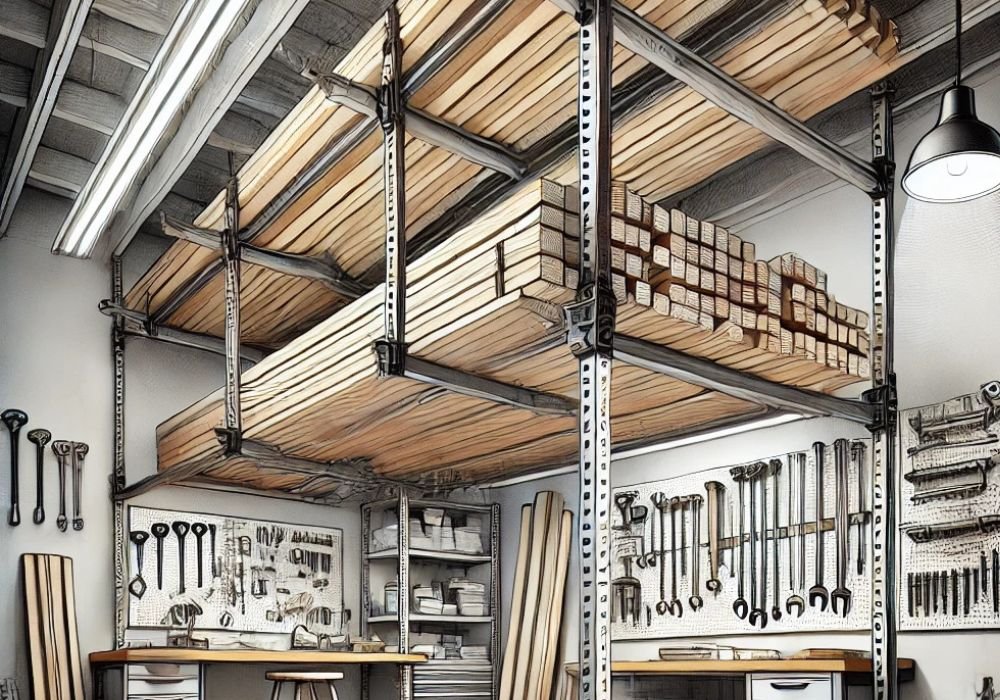
Overhead Storage Systems
Overhead storage systems are a clever way to keep your workshop or garage organized without taking up any floor space. Utilizing the ceiling allows you to store lumber and other materials out of the way while keeping them accessible when needed. These systems are especially useful in small spaces where every square foot matters.
Why Choose Overhead Storage Systems?
Ceiling-mounted racks provide a practical solution for storing long or bulky pieces of lumber that might otherwise clutter your workspace. They free up wall and floor space, creating more room for workbenches, tools, and other equipment. Overhead systems also protect your materials from damage caused by moisture or accidental spills on the ground.
Another benefit is their ability to handle significant weight. Many overhead storage systems are designed to support heavy loads, making them suitable for large-scale DIY projects or home renovations. Additionally, they can be configured to store not just lumber but other items like seasonal tools or bins, adding versatility to your storage setup.
Key Features of Overhead Storage Systems
Overhead storage racks come in various styles and sizes, but the best systems for lumber storage share a few common features:
Adjustable Height and Length: The features of these overhead lumber rack ideas allow you to customize the system based on your lumber dimensions and ceiling height.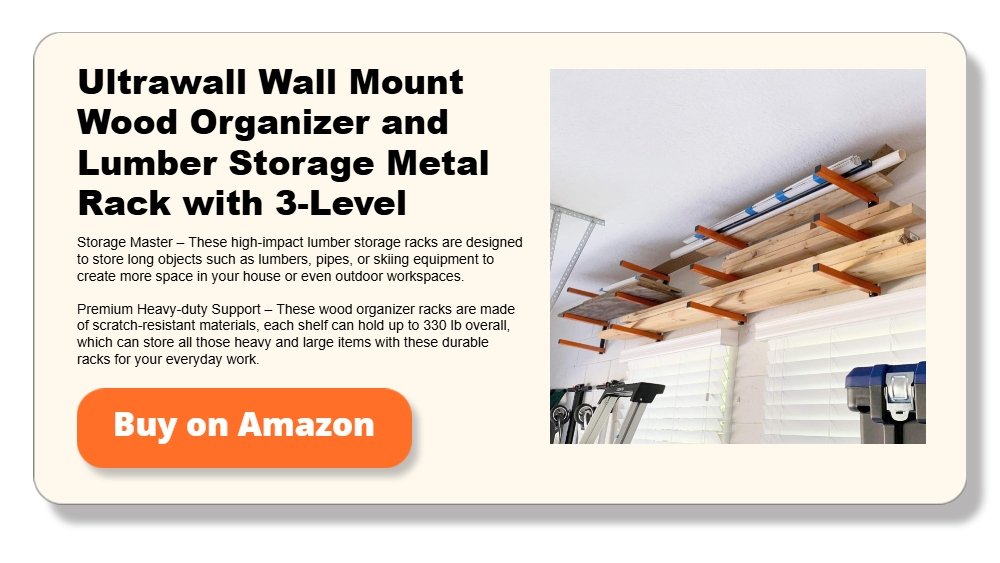
High Weight Capacity: Look for racks made of durable materials like steel to ensure they can safely support heavy wood pieces.
Accessibility: Some systems include pulley mechanisms or drop-down features, making accessing stored items easier without a ladder.
Installation Considerations
Installing an overhead lumber rack ideas requires careful planning to ensure safety and functionality. Begin by selecting a sturdy section of your ceiling, preferably one supported by joists or beams. Avoid installing racks into drywall alone, as it cannot support heavy loads. Use lag bolts or heavy-duty screws for secure installation.
Measure your ceiling height and consider the clearance needed for other objects in your garage or workshop, such as garage doors, lights, or fans. Ensure enough space to maneuver lumber in and out of the rack without obstruction.
For DIY enthusiasts, building a custom overhead storage system is a cost-effective alternative to purchasing a pre-made rack. Use heavy-duty steel brackets and beams to create a robust structure. Add rollers or sliders to simplify access if you frequently need to retrieve your materials.
Tips for Organizing Lumber on Overhead Racks
When using an overhead system, organization is essential to maximize storage space. Group similar lumber types and sizes together to avoid searching for the right piece. Place frequently used items toward the edges for easier access, while rarely used materials can stay in the center or higher up.
Label sections or create a simple inventory list if you store multiple types of wood. This step is particularly useful for large collections, saving time when starting a project.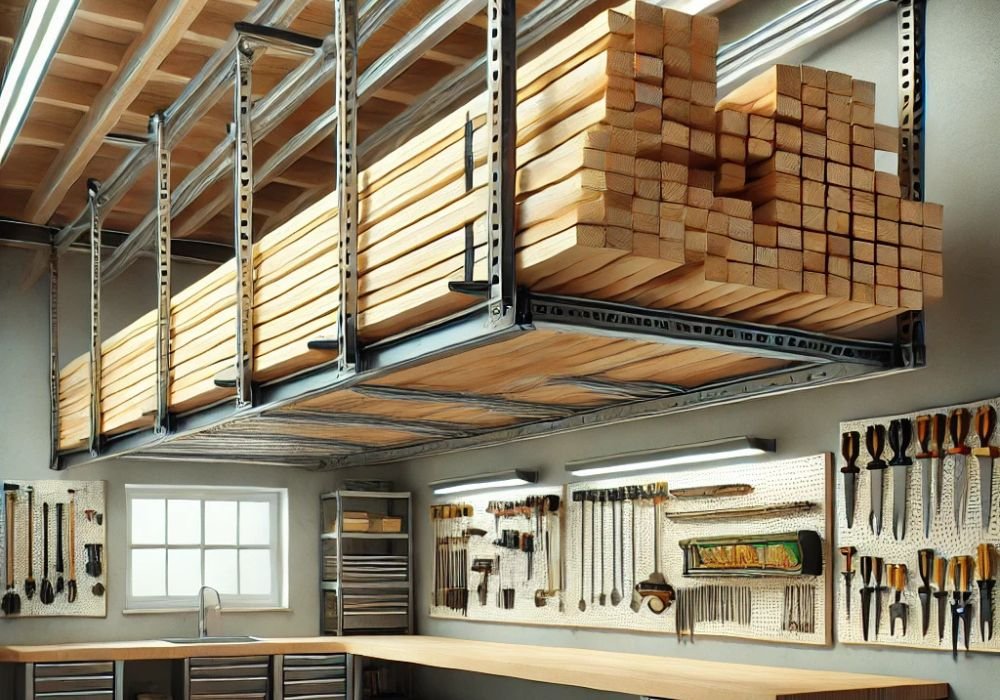
Best Applications for Overhead Storage Systems
Overhead storage systems are ideal for workshops, garages, or sheds with high ceilings. They’re particularly useful for storing long boards, beams, or plywood that are too cumbersome to store vertically or on wall-mounted racks. These systems work well for anyone juggling multiple projects and needing an efficient way to keep materials organized and out of the way.
Using overhead space will transform your small workspace into a more functional and clutter-free environment. With the right system in place, you can focus on your projects instead of dealing with messy piles of lumber.
Rolling Lumber Carts
Rolling lumber carts are an excellent storage solution for anyone working in a compact space. These lumber rack ideas combine the convenience of mobility with the ability to neatly organize lumber of various sizes. Whether you’re working in a small workshop or a shared garage, a rolling lumber cart keeps your materials accessible and easy to transport.
Why Choose Rolling Lumber Carts?
Unlike fixed storage solutions, rolling carts offer unmatched flexibility. You can move them to wherever you’re working, making them perfect for workshops with limited room. When not in use, you can simply roll the cart out of the way to free up floor space.
They are especially useful for storing a mix of short and long lumber pieces. With compartments or dividers, rolling carts can help you categorize materials, so you don’t waste time searching for the right size. Their mobility also makes them great for transporting wood from storage to your workbench or cutting area.
Key Features of Rolling Lumber Carts
Rolling lumber carts are highly customizable, with features that enhance their utility:
- Multiple Storage Sections: Most carts include both vertical and horizontal storage compartments, allowing you to store shorter pieces upright and longer boards flat.
- Heavy-Duty Casters: These wheels are essential for smooth movement, even with a fully loaded cart. Look for locking casters to keep the cart stable when stationary.
- Durable Frame: A sturdy frame made of steel or reinforced wood ensures the cart can handle heavy loads without tipping or bending.
DIY vs. Pre-Made Carts
Pre-made rolling carts are available at hardware stores and online, offering professional-grade solutions that can handle significant weight. These are ideal for those who prefer a ready-to-use option without the hassle of assembly.
However, if you enjoy DIY projects, building your own rolling lumber cart can be a rewarding and cost-effective option. With some basic materials like plywood, 2x4s, and heavy-duty casters, you can create a custom cart tailored to your space and lumber storage needs. Add dividers, shelves, or hooks to maximize functionality.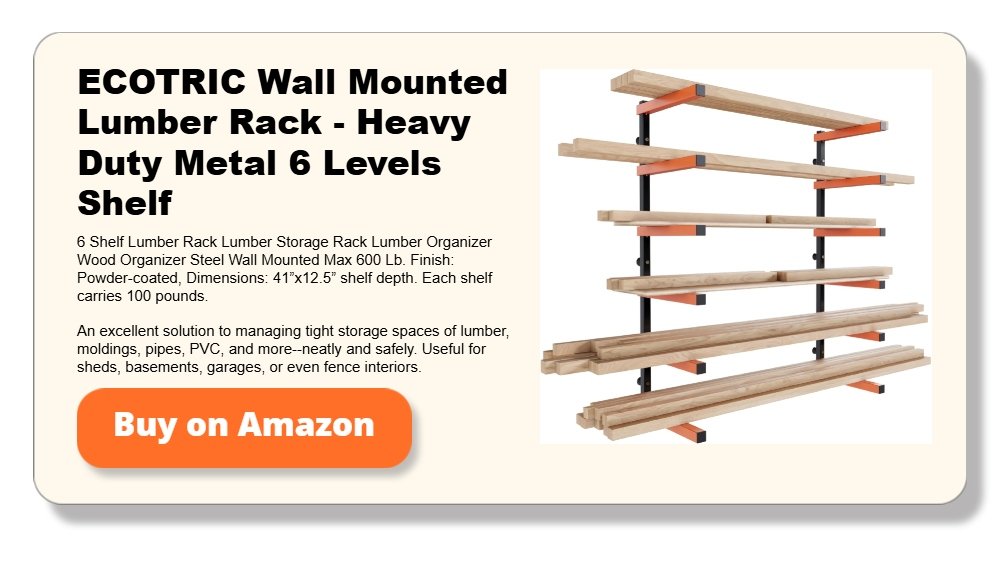
Building a DIY Rolling Lumber Cart
A simple DIY cart starts with a sturdy base. Use thick plywood for the bottom platform and attach four heavy-duty casters to the corners. Construct vertical dividers to separate different types of lumber and secure them with wood screws and glue for stability.
For added convenience, consider adding a small shelf or bin for storing tools, nails, or offcuts. This feature turns your cart into a multi-functional storage unit, keeping everything you need for your project in one place.
Organizing Lumber on a Rolling Cart
To make the most of your rolling lumber cart, arrange lumber by size and type. Use the vertical section for shorter offcuts and the horizontal shelves for longer boards. Keep frequently used materials in the most accessible sections of the cart.
Label each section or use color-coded markers to quickly identify different wood types. This simple step can save time and ensure your cart stays organized, even during busy projects.
Best Applications for Rolling Lumber Carts
Rolling lumber carts are ideal for workshops or garages where flexibility and mobility are essential. They’re particularly useful for those who frequently switch between different workstations or need to store various wood types.
Whether you’re a professional carpenter or a hobbyist, a rolling lumber cart simplifies your workflow by keeping your materials within arm’s reach. It’s a practical, space-saving solution that helps you stay organized while making your workspace more efficient.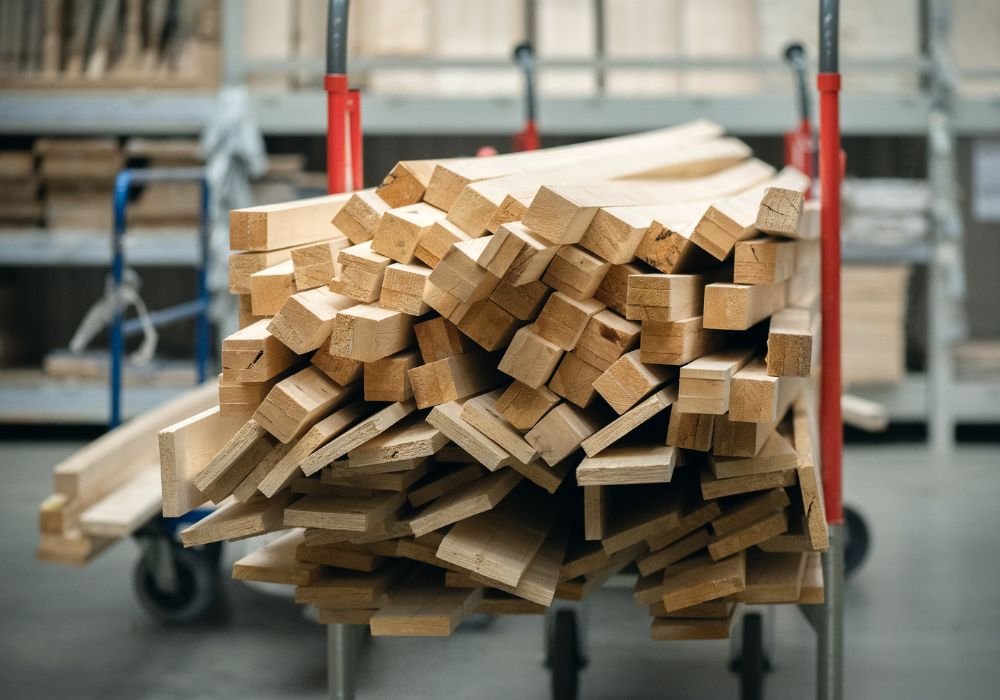
Compact Vertical Lumber Storage
Compact vertical lumber storage systems are perfect for small workshops or garages where every square foot counts. By storing wood upright, these lumber rack ideas minimize the footprint of your lumber while keeping materials accessible and organized. Whether you’re working on a DIY project or managing renovation tasks, vertical storage can transform a cluttered space into a tidy, efficient workspace.
Why Choose Vertical Lumber Storage?
Vertical storage uses unused corners or narrow spaces in your workshop. It allows you to store wood of various lengths without stacking or laying it flat, which can take up more room. This method also keeps your materials visible, so you can quickly find the right piece without shuffling through piles.
One key advantage of vertical storage is that it helps protect wood from damage. Laying lumber flat on the floor can expose it to moisture or warping. Storing it vertically ensures better air circulation, which helps maintain the integrity of the wood over time.
Features of Compact Vertical Storage Systems
Vertical storage solutions come in various styles, from pre-made racks to simple DIY designs. Here are some key features to look for:
- Stable Base: A sturdy base is critical for preventing tipping or instability. Many racks include wide supports or weighted bottoms for added safety.
- Adjustable Dividers allow you to separate lumber by size or type, keeping everything neatly organized.
- Compact Design: These racks are designed to fit into tight spaces, such as corners or narrow walls.
DIY Vertical Lumber Storage
Creating your vertical lumber storage is a straightforward DIY project that requires minimal materials and time. To create a stable platform, start by building a base using plywood or 2x4s. Attach vertical supports to the base at regular intervals. Depending on the weight and size of the lumber you plan to store, these supports can be made from scrap wood or PVC pipes.
For added stability, anchor the rack to the wall with brackets or screws. This step is especially important if you’re storing taller or heavier pieces of wood. You can also add dividers or hooks to separate different wood types or lengths, making your storage system even more organized.
Tips for Safe Vertical Storage
Safety should be a priority when using vertical lumber rack ideas. Always ensure the base is sturdy enough to support the weight of your lumber. If storing long pieces, lean them against the wall to prevent tipping. Avoid overloading the rack, as this can make it unstable.
It’s also a good idea to sort lumber by size, with shorter pieces in the front and longer ones in the back. This arrangement makes it easier to access what you need without disrupting the entire rack.
Best Applications for Compact Vertical Storage
Vertical lumber storage is ideal for workshops, garages, or sheds with limited floor space. It works particularly well for smaller collections of wood or for organizing offcuts that might otherwise clutter your workspace. This solution is also great for hobbyists or DIY enthusiasts who need a simple yet effective way to organize their materials.
Choosing a compact vertical storage system will free up valuable space while keeping your workspace safe and efficient. This smart solution ensures that even in the smallest spaces, you’ll have everything you need for your projects within easy reach.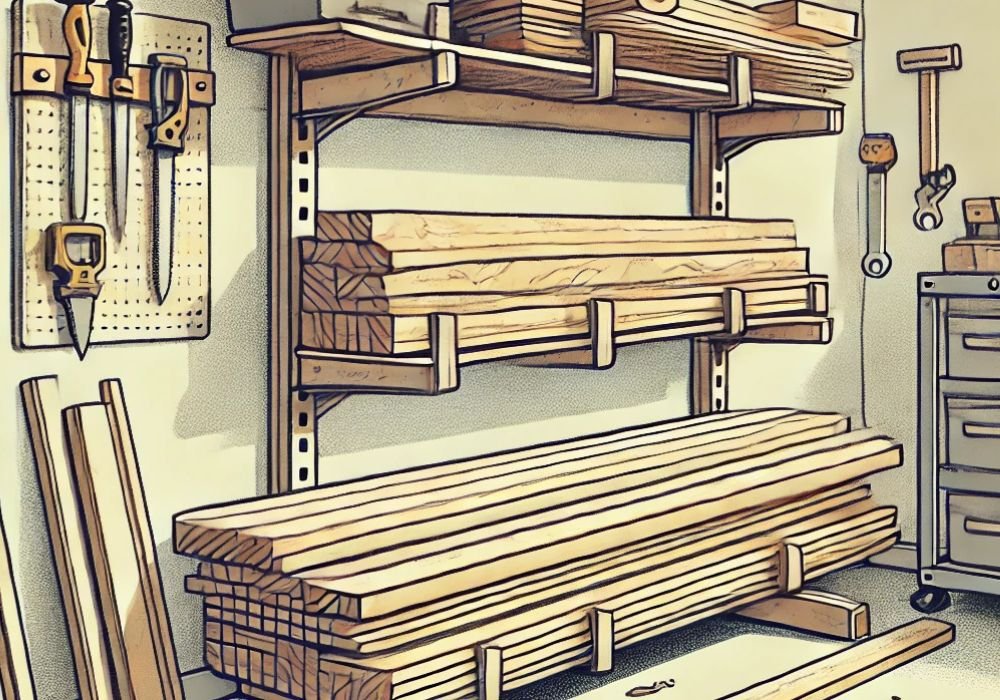
DIY Combination Racks
DIY combination racks are the ultimate solution for those who need a flexible and cost-effective way to store lumber in small spaces. These racks combine vertical and horizontal storage, allowing you to organize different sizes and types of wood in one compact structure. Whether you’re a hobbyist or a seasoned craftsman, a DIY combination rack can be tailored to fit your specific needs, making it a smart addition to any workshop or garage.
Why Choose a DIY Combination Rack?
Combination racks offer unmatched versatility. They allow you to store long boards horizontally while keeping shorter pieces or offcuts upright. This dual functionality means you don’t have to choose between a vertical or horizontal system. You get the best of both worlds.
By building your own rack, you can customize it to suit the dimensions of your space and the type of lumber you typically use. A DIY rack is also a cost-effective option, as it can be constructed using scrap materials or affordable items like 2x4s, plywood, and brackets.
Benefits of a DIY Combination Rack
One of the biggest advantages of DIY combination lumber rack ideas is its adaptability. You can modify the design over time as your storage needs change. It’s also an excellent way to repurpose leftover materials from other projects, reducing waste and keeping costs low.
The dual storage setup keeps your lumber organized and easy to access. Horizontal shelves prevent long boards from sagging, while vertical sections make it simple to grab smaller pieces without digging through piles.
Best Uses for DIY Combination Racks
Combination racks are ideal for workshops or garages where you need to store various types of wood in a single space. They’re perfect for managing materials for multiple projects, from large renovation tasks to smaller DIY crafts.
By building a DIY combination rack, you’ll create a storage solution that’s functional and tailored to your workspace. This customizable approach ensures your lumber stays organized, accessible, and ready for your next project.
Conclusion
Choosing the right lumber rack ideas can transform a cluttered workspace into an organized and efficient area. Each idea offers unique benefits tailored to small spaces, helping you keep materials accessible and safe. With the right system in place, you’ll save time, reduce frustration, and enhance your DIY or renovation projects.
We have more ways on boosting your workspace for wood projects. Check out our guide on setting up your woodworking shop!






